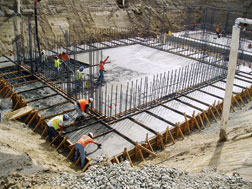
Photo: Using Extended Enterprise, Sacramento projects came in $23 million under budget.
|
In an increasingly cutthroat construction market, the words partnership and alliance often become meaningless corporate buzzwords. Now Raleigh, N.C.-based consulting firm FMI is showing contractors and owners that the best way to turn profits for both parties is to stop the bloodshed.
Many partnerships between owners and contractors are comprised of little more than a partnering meeting during the planning stages of a project, says Bill Meloche, FMI consultant. Rarely are common goals set and followed. Without a shared vision, the two sides quickly revert to trying to squeeze as much out of the other as possible, he says. To combat that adverse trend, FMI has created a 10-step program called the Extended Enterprise, which is a comprehensive program for forging partnerships that result in the unification of goals and efforts.
FMI has proven that fully developed alliances between owner and contractor can result in lower costs and better margins, particularly on large programs and megaprojects. There are five key elements in Extended Enterprise—shared vision, building trust, creative collaboration, strategic integration and process innovation. When it works, a partnership emerges that helps everyone see a better bottom line.

|
"It is more important to get the mid- and low-level people to buy into the process." — Bill Meloche, FMI
|
Extended Enterprise is an in-depth process where two companies come together, entwining their management, personnel and decision making. Laying the groundwork can take from six months to a year. FMI has found that most successful alliances follow a paradigm; so once the two parties have established their common goals, they create a 30-page to 50-page success story. “The success story tells events before they happen. It predicts nuisances, obstacles, and setbacks that are typical to this situation. It is not a business document,” says Meloche.
The next phases of the process focus on building trust and creating open and honest communications between the two sides. FMI works on bridging both formal and informal communications. Each side needs to relinquish its potentially exclusionary vernacular.
As communications improve, FMI directs the discussion towards improving the process. A variety of tools are deployed, including business improvisation. “We use something called the ‘yes…and’ approach. When someone suggests an idea, instead of shooting it down because it didn’t work in the past, someone else says ‘yes and why don’t we do it this way since it didn’t work that way last time,’” says Meloche.
As the participants move through the process, potentially persuasive individuals are identified as “storytellers.” The storytellers come from all levels of the organization and are tasked with campaigning for the alliance. “In our experience, it is more important to get the mid- and low-level people to buy into the process,” says Meloche. The storytellers are crucial to the process because the full benefits of the Extended Enterprise are not realized until all levels of both organizations have bought into it, a process that can take anywhere from two to five years.
Because of the duration of the process, the “success story” acts as a crucial road map and a reference. “The story engages the participants to take action in ways that they would not with a strategic plan,” says Meloche. Success is about relationships between people. If you focus solely on accomplishing goals with no mind to the relationships, it does not succeed. The success story is also mapped on a...

Post a comment to this article
Report Abusive Comment